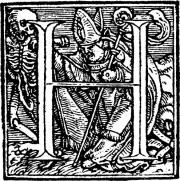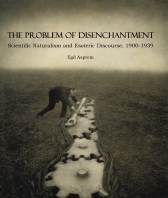Following up the last post, here comes a report on the esotericism panels at the IAHR in Toronto, organized by Marco Pasi. As you can read about below, they go straight into a central debate in the field of esotericism studies at the moment.
On Thursday and Friday, we had three sessions dedicated to exploring one of the persistent conceptual and methodological problems in research on esotericism: The qualifying term “Western”. Whence from, why, and what to do with it?
With a total of ten papers, I won’t go into details on all that was said (also, the second post over at Heteropraxis talked about this). In stead, I can systematize them into three groups: Historical reflections on the origins of a “western” identity for esotericism; theoretical and methodological reflections on the analytical content, usefulness, restrictions, and future of the word; and specific case studies, dealing with the east-west dynamic in esotericism research.

It's not rocket science, but they decided to put us esoteric heterodoxologists with the physical laboratories.
In the latter category belongs Henrik Bogdan’s paper on the obscure Holy Order of Krishna, based in India, which appropriated parts of Aleister Crowley’s thelemic doctrine and fused it with Hindu conceptions. An interesting and little known case indeed, based on Bogdan’s research for the recently published book Brother Curwen, Brother Crowley: A Correspondence, which presents the documentary evidence. Accidentally, another Crowley-related paper may be mentioned in this category, namely John L. Crow’s analysis of the geographic distribution of the Ordo Templi Orientis, and its spread over time. The most interesting thing about Crow’s paper was his demonstration of the use of quantitative data and mapping techniques based on the skillful use of software for analysing modern and contemporary esoteric currents. Finally, a paper which certainly went from discussion of case, but in the direction of questioning more analytic conceptions, was Gordan Djurdjevic’s, on the analysis of tantric and yogic practices, texts and currents under the rubric of esotericism. This led to an interesting debate, which I think touched the core of the problem: whether the term “esotericism” should be used as a largely ahistorical analytic construct, or taken to signify specific historical currents (more on that in a bit).
Next, however, I should mention the (in my opinion) very interesting work which is now being done into digging up the genalogy of the notion of esotericism as a western phenomenon. Here we had two papers in particular, that follow each other only to a certain point.
First, my colleague and supervisor Wouter J. Hanegraaff has spent the last half decade researching this and related issues (sneak advertisement: his next book will clarify all of this…). Put (very) shortly: Wouter sees the concept of esotericism (as opposed to the word on the one hand, and the specific authors, currents, texts, etc. typically covered by it on the other), i.e. the idea that certain streams of thought and practice have something in common which is now recognized by the academy as “esotericism”, as arising from a complicated set of historical processes. We may however attempt to identify two major steps: one “positive” the other “negative”.
The first is the formation of a certain way of remembering the past, of historiography if you will (but more properly, perhaps, mnemohistory), in the renaissance. This has to do with such concepts as prisca theologia and philosophia perennis – visions of wisdom and truth, about religion, the world, and, well, everything, being passed down from primordial sources (such types as Moses, Hermes, and Zarathustra), or alternatively the idea that such ultimate truth is always present through the ages, and emerges through certain historical spokespersons. At any rate, you get genealogies of wisdom and capital-T “Tradition”. In Wouter’s thesis, the prominence of this way of thinking (or remembering) is tied up with the concept of “Platonic Orientalism” – the notion already present in late antiquity, that great philosophers had their insights from travels to “the East” and encounters with the sages of Egypt, Chaldea, or even India. At any rate: What matters here is that, in the renaissance, this gave rise to attempts at including pagan authors in the Christian, or “pre-Christian Christian” canon. And with it the revival of magic as a part of Christian religious praxis.
This, then, is largely what “renaissance esotericists” such as Ficino and Pico were all about. But the identification of these and other authors (now including the whole field of Hermeticism, renaissance Platonism, Christian Kabbalah, etc.) as one large related historical entity – actually, a single related heresy – was the joint invention of Protestant and Enlightenment polemicisers, according to Wouter. The so-called anti-apologeticism of some Protestant reformers saw a threatening “hellenization of Christianity”, which to them was equal to a lapse into paganism. And hence the process of extirpating anything hellenic – hermetic, platonic, magical – started. Accidentally, in writing new histories and once again turning the mnemohistory of the “West” around, these instances of “Platonic-Hermetic Christianity” became “rejected currents” which, later – in the 19th century, were covered by the term “esotericism”.
In short: By replacing the emergence of a historical concept of esotericism in a set of polemical discourses, and their construction of collective memory, Wouter Hanegraaff argues that we find new reasons for seeing esotericism as a uniquely Western, indeed perhaps European, phenomenon.
For the full argument you need to wait for Wouter’s book.
In the meantime, on to our colleague Marco Pasi’s paper. Marco similarly takes a historical approach, but locates the idea of the “Western” in “Western esotericism” somewhat later: in the context of 19th century occultism, to be precise.
The point is the internal splits and controversies in (particularly English) occultism in the last quarter of the century, which Joscelyn Godwin has earlier described as “the parting of East and West”. Historically, this has to do with the tensions created by the dominance and high profile of the Theosophical Society – as well as, perhaps, certain expected consequences of the colonial eclecticism of Victorian occultists searching for exotic truths. We may even see this in combination with the genealogies of wisdom mentioned above: by the Victorian period, Hermes and Zarathustra got competition from Krishna, Buddha and Laotze. With the Theosophical Society’s increasing emphasis on “the East”, the “Hermetic” currents (such as the Hermetic Society, the Hermetic Brotherhood of Luxor, and the Hermetic Order of the Golden Dawn, to mention the notables) – interestingly quite in opposition to what Platonic Orientalists had been thinking – started signifying a Western identity. At this point, then, we get an internal polemic which differentiates between “Eastern” and “Western” schools of “mystery traditions”.

Alchemy is often described as pseudo-chemistry. But judging from the signs on the wall of one of the chemistry buildings of the University of Toronto, chemistry looks a lot like pseudo-alchemy as well.
At this point, I will silently pass Steven Wasserstrom’s paper on hermetisms between arabic, jewish and christian contexts (a topic he in my opinion has written much better about before than he was able to show in the paper), and go directly to the last category of papers: the theoretical and methodological ones. Funnily enough, this group is all Nordic, made up by Kennet Granholm, Søren Feldtfos Thomsen, and myself (in addition, the Swedish Satanism specialist Per Faxneld was added to our panel with his paper on the uses of Lilith, after his own “Satanism studies” panel had been cancelled).
At any rate, there were some interesting overlaps in this theoretical panel. First, Kennet gave an overview of the many and ambiguous meanings of “the West”, and discussed some implications of Samuel P. Huntington’s thesis of the “clash of civilizations” in that perspective. In short, “the West” is not only imprecise and unanalytical – it also carries with it certain connotations which have wider political and cultural bearings. Kennet’s suggestion is to drop the term altogether, and stick with “esotericism” alone, however we define it.
A somewhat different approach was taken by Søren, who argued strongly for more deductive approaches in esotericism research. This point ties in with a distinction which has been made in recent years between “typological” and “historical” approaches to esotericism in the academia, where it is the historical ones that have emphasised the qualifier “Western”. The typological ones tend to be universalist and “deductive”, whereas the historicist ones are particularistic and “inductive”, in the sense that their aim is to describe phenomena. Søren’s point was that, whereas the historical-inductivist approaches have dominated the field over the last 20 years or so, there is much that could be gained from embracing deductive programmes – such as the “integral” discursive model developed by Kocku von Stuckrad. Particularly, these would be able to allow for a new and more robust comparative study, and through this forge new and more solid links with the academic community which esotericism research is supposed to be a part of: the history of religion.
I am not going to say too much about my own paper at this point. However, it took off from Søren’s point, but went in a somewhat different direction. My own analysis is that there exists a situation in which there are a number of different and irreconcilable research programmes which lay claim to the concept of esotericism – i.e. typological and historical programmes. Since these programmes have embedded the concept into very different sets of research goals, questions and methodological frameworks, I think that there can be no reconciliation in terms of definition. Not on any rational level, at least. Therefore, coming from a “science studies” analysis of my own field, invoking boundary-work, Lakatosian research programmes, and boundary objects, I argued that the solution must come rather from a political negotiation of these irreconcilable differences, and the creation of a sort of “boundary discipline”, focusing on “esotericism” as a “boundary object”. We must live with it as elusive, but we can try to agree upon a division of labour, a recognition of differences, and lay the polemical boundary-work behind us.
Enough said.
Now, there are promising prospects about a publication resulting from these sessions. If that happens, I think we will get a central and important contribution to the development of this young but blossoming field.






Egil, you forgot to say that the papers presented “cutting edge research” and that you’re paper focused on a “grand unified theory of esotericism” 🙂
Love your comment about chemistry looking a lot like pseudo-alchemy!
[…] the term “esotericism” has been the object of research over the years (mentioned here previously), and the tool is well equipped to help researchers in the future. Indeed, it is especially in this […]
[…] book, Esotericism and the Academy: Rejected Knowledge in Western Culture. The book has briefly been mentioned on Heterodoxology before, but now we can refer to the official abstract from CUP: “Academics tend to look on […]
[…] Gordan’s book is not only about “influences”, as the title suggests, but equally about comparison. This point is made clear in the introduction and chapter one especially. In fact, chapter one of this book shares its origins with my own article: they were both articulated first as conference papers in a panel on “Western esotericism and its boundaries” at the IAHR conference in Toronto in…. […]